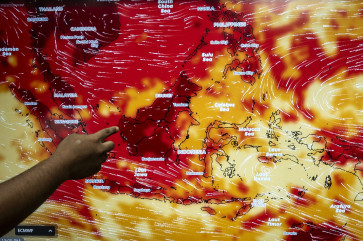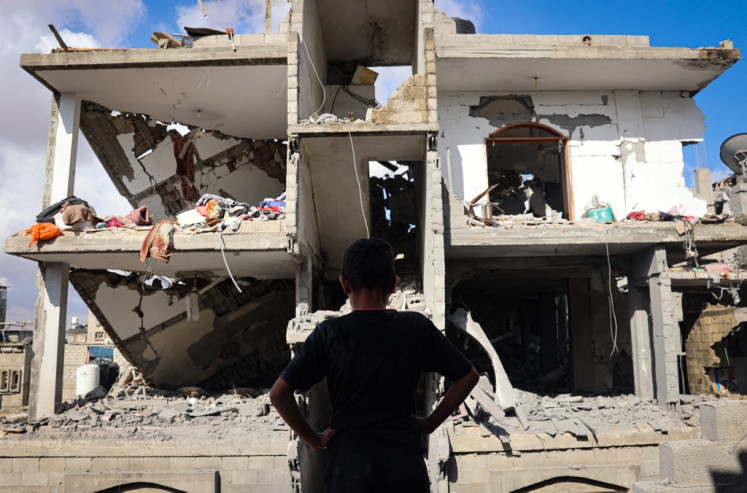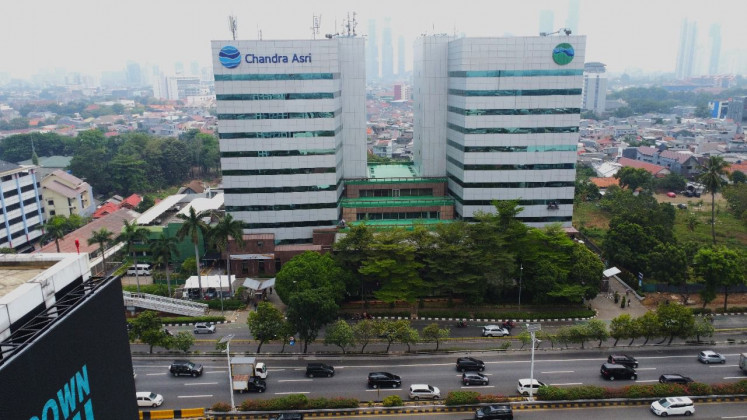From diapers to cold feet, a Tokyo disaster survival guide
This combination of Thursday Associated Press photos demonstrate the process of an Associated Press journalist making a diaper with a plastic bag, a towel, and a pair of scissors as illustrated in the Tokyo Metropolitan Government Office's Tokyo Disaster Manual distributed to Tokyo households
Change Size
 This combination of Dec. 17 Associated Press photos demonstrate the process of an Associated Press journalist making a diaper with a plastic bag, a towel, and a pair of scissors as illustrated in the Tokyo Metropolitan Government Office's Tokyo Disaster Manual distributed to Tokyo households. (AP/Penny Yi Wang)" border="0" height="289" width="512">This combination of Thursday Associated Press photos demonstrate the process of an Associated Press journalist making a diaper with a plastic bag, a towel, and a pair of scissors as illustrated in the Tokyo Metropolitan Government Office's Tokyo Disaster Manual distributed to Tokyo households. (AP/Penny Yi Wang)
This combination of Dec. 17 Associated Press photos demonstrate the process of an Associated Press journalist making a diaper with a plastic bag, a towel, and a pair of scissors as illustrated in the Tokyo Metropolitan Government Office's Tokyo Disaster Manual distributed to Tokyo households. (AP/Penny Yi Wang)" border="0" height="289" width="512">This combination of Thursday Associated Press photos demonstrate the process of an Associated Press journalist making a diaper with a plastic bag, a towel, and a pair of scissors as illustrated in the Tokyo Metropolitan Government Office's Tokyo Disaster Manual distributed to Tokyo households. (AP/Penny Yi Wang)You're faced with a big disaster, like an earthquake, plus a small one â say, running out of diapers. What can you do? Cut open a plastic supermarket bag, place a small towel on it and wrap your baby up.
That's one of many tips issued by the Tokyo city government in a 300-page illustrated disaster guide that has been two years in the making.
Have an AA battery but need a C? Cut handkerchiefs to the right height and wrap the cloth around the battery until it's thick enough for the larger slot. Cold feet (literally)? Put crumpled newspapers in a large plastic bag and stick your legs inside.
 This image released by Tokyo Metropolitan Government Office shows pages from the Tokyo Disaster Manual distributed to Tokyo households. (Tokyo Metropolitan Government Office via AP)
This image released by Tokyo Metropolitan Government Office shows pages from the Tokyo Disaster Manual distributed to Tokyo households. (Tokyo Metropolitan Government Office via AP)
With a low crime rate, Japan is one of the safest places in the world, but it is also prone to natural disasters. A 2011 earthquake and tsunami left more than 18,000 people dead or missing in the northeast. The last major earthquake in Tokyo, in 1923, sparked fires that burned wide swaths of the city and killed 140,000 people in the area.
The Tokyo disaster guide, with every page printed on bright yellow paper, is intended to help citizens prepare for and survive a major emergency in which power, water and heat may be lost for days. It opens with an ominous warning: "It is predicted that there is a 70 percent possibility of an earthquake directly hitting Tokyo within the next 30 years. Are you prepared?"
The advice ranges from using a shopping basket to protect your head as items tumble in a grocery store to translations of 10 English questions ("Where is the emergency shelter?") to understand foreigners who need help. The tips are dispensed in brief nuggets accompanied by simple illustrations. For example: "Your whole body will be warmed if you place a plastic bottle with hot water under your arm."
span class="inline inline-center">This combination of Thursday Associated Press photos demonstrate the process of an Associated Press journalist making a diaper with a plastic bag, a towel, and a pair of scissors as illustrated in the Tokyo Metropolitan Government Office's Tokyo Disaster Manual distributed to Tokyo households. (AP/Penny Yi Wang) You're faced with a big disaster, like an earthquake, plus a small one ' say, running out of diapers. What can you do? Cut open a plastic supermarket bag, place a small towel on it and wrap your baby up. That's one of many tips issued by the Tokyo city government in a 300-page illustrated disaster guide that has been two years in the making. Have an AA battery but need a C? Cut handkerchiefs to the right height and wrap the cloth around the battery until it's thick enough for the larger slot. Cold feet (literally)? Put crumpled newspapers in a large plastic bag and stick your legs inside. With a low crime rate, Japan is one of the safest places in the world, but it is also prone to natural disasters. A 2011 earthquake and tsunami left more than 18,000 people dead or missing in the northeast. The last major earthquake in Tokyo, in 1923, sparked fires that burned wide swaths of the city and killed 140,000 people in the area. The Tokyo disaster guide, with every page printed on bright yellow paper, is intended to help citizens prepare for and survive a major emergency in which power, water and heat may be lost for days. It opens with an ominous warning: "It is predicted that there is a 70 percent possibility of an earthquake directly hitting Tokyo within the next 30 years. Are you prepared?" The advice ranges from using a shopping basket to protect your head as items tumble in a grocery store to translations of 10 English questions ("Where is the emergency shelter?") to understand foreigners who need help. The tips are dispensed in brief nuggets accompanied by simple illustrations. For example: "Your whole body will be warmed if you place a plastic bottle with hot water under your arm." The authors consulted more than 100 experts around the world. A free copy was mailed to all Tokyo households. Requests from others, notably commuters to Tokyo, prompted the city to distribute the rest to bookstores. They have sold out at 140 yen (US$1.15) each, and another printing is in the works. The book also has been translated into English, Chinese and Korean. Total cost: 2 billion yen ($16.4 million). No Japanese project would be complete without a mascot, and the guide's is a disaster preparedness rhino, a hard-hatted figure eagerly undertaking relevant actions at the start of each chapter. "Bosai" the rhino is described as a very curious guy who is easily frightened ' two useful characteristics, perhaps, to get prepared for the big one.
T


Your Opinion Matters
Share your experiences, suggestions, and any issues you've encountered on The Jakarta Post. We're here to listen.
Thank You
Thank you for sharing your thoughts. We appreciate your feedback.









